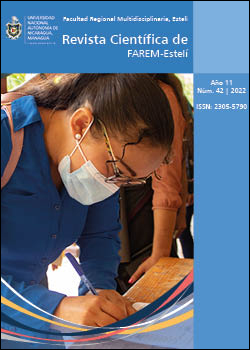Evaluación de factores que inciden en el proceso de deshidratación solar térmica
DOI:
https://doi.org/10.5377/farem.v11i42.14699Palabras clave:
Deshidratación, radiación solar, tiempo de secadoResumen
La presente investigación tuvo como propósito el diseño, construcción y evaluación de un prototipo de deshidratación de frutas y legumbres mediante el aprovechamiento de energía solar térmica. Se realizó un estudio de tipo experimental, descriptivo, correlacional. El prototipo se diseñó en el programa Sketchup, se creó en Excel una hoja de recolección de datos que contenía todas las variables de interés. Para las mediciones de las variables se colocaron sensores en diferentes partes del prototipo. Los resultados demuestran efecto significativo de la radiación solar para disminuir el tiempo de secado de la cebolla, así mismo se demostró correlación significativa entre la temperatura, velocidad del viento, radiación y el tiempo de secado (r= -0.81; p = 0.0001), (r= -0.59; p = 0.0039), (r= 0.60; p = -0.0221). Se concluye que el tiempo de secado de la cebolla es aceptable tomando en cuenta que las pruebas se realizaron en días con poca radiación y con presencia de lluvia, el tiempo de secado estuvo determinado por la correlación significativa entre la radiación, velocidad del viento y la temperatura de la cámara.
Descargas
Citas
Araya, G. (2012). Manual de recomendaciones para el cultivo de cebolla (Allium cepa L). San Josè, Costa Rica: MAG/INTA. Recuperado el 12 de Julio de 2022, de http://www.mag.go.cr/bibliotecavirtual/F01-10393.PDF
Bejarano Martinez, c. a. (2018). Evaluacion del Efecto de Uso de un Deshidratador Solar pasivo Indirecto de flujo Turbulento y de un Deshidratador Solar pasivo en Propiedades Fisioquimicas y Organolecticas de mango, Naranjas y mandarinas . Tesis de Maestria, Tocaima. Recuperado el 19 de Mayo de 2020
Brewster, J. (1994). Onions and vegetable alliums (Segunda ed.).
Calero, L. C. (2014). Estudio de un secador solar indirecto por convección natural para el deshidratado de frutas y vegetales en Nicaragu. Leon.
Castellon , J., & Espinoza, W. (2009). Validación del uso de un secador Solar de Café. Tesis de grado , Esteli. Recuperado el 12 de Junio de 2020
ecoteca. (2020). ECOTEC. (Virtual, Editor) Recuperado el 11 de 10 de 2020, de https://ecotec.unam.mx/ecoteca/deshidratadores-solares-2
Martínez, C. A. (2018). Evaluación del Efecto del Uso de un Deshidratador Solar Pasivo Indirecto de Flujo Turbulento y de un Deshidratador Solar Pasivo en Propiedades Fisicoquímicas y Organolépticas de Mango, Naranja y Mandarina. Colombia.
Moncayo, M. V., Roa M, G. L., & Ortega Torres, D. B. (2011). Diseño y Construcción de un Secador Solar por Convección de Aire Caliente Automatizado de Pequeña Escala, para el Secado de café para la Universidad Nacional de Loja. Loja.
Moraga Castro, J. J. (2013). Evaluación del proceso de secado de café pergamino en Beneficio Sajonia S.A. Matagalpa 2012. tesis de grado. Recuperado el 5 de mayo de 2020
Nevarez , R., & Cuzme, X. (2016). EFECTOS DE TEMPERATURA Y TIEMPO DE DESHIDRATACIÓN, EN CARACTERÍSTICAS FÍSICAS Y SENSORIALES DE CEBOLLA PERLA (Allium cepa L) EN POLVO. Tesis de grado, Calceta. Recuperado el 12 de Mayo de 2020
Pulfer, J. C. (2008). Cocinas y secadores solares (Segunda edición ed.). Barcelona: UPC.
Sampier Hernandez, R., Fernandez Collado, C., & Lucio Baptista, P. (2007). En R. Sampier Hernandez, C. Fernandez Collado, & P. Lucio Baptista, Metodologia de la investigacion. McGraw-Hill Interamericana.
www.infoagro.com. (Abril de 2008). Obtenido de https://www.infoagro.com/hortalizas/cebolla.htm
Publicado
Número
Sección
Licencia
Derechos de autor 2022 Revista Científica de FAREM-Estelí

Esta obra está bajo una licencia internacional Creative Commons Atribución-NoComercial-CompartirIgual 4.0.



